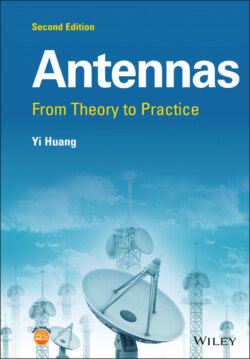Читать книгу Antennas - Yi Huang - Страница 24
1.4.2 Magnetic Field
ОглавлениеWhilst charges can generate an electric field, currents can generate a magnetic field. The magnetic field, H (in A/m), is the vector field that forms closed loops around electric currents or magnets. The magnetic field from a current vector I is given by the Biot–Savart law as
(1.23)
where
is the unit displacement vector from the current element to the field point and
r is the distance from the current element to the field point.
I, and H follow the right‐hand rule, that is H is orthogonal to both I and , as illustrated by Figure 1.12.
Figure 1.12 Magnetic field generated by current I
Like the electric field, the magnetic field exerts a force on electric charge. But unlike an electric field, it employs force only on a moving charge, and the direction of the force is orthogonal to both the magnetic field and the charge's velocity:
(1.24)
where
F is the force vector produced, measured in Newtons;
Q is the electric charge that the magnetic field is acting on, measured in Coulombs (C);
v is the velocity vector of the electric charge Q, measured in meters per second (m/s);
μ is the magnetic permeability of the material. Its unit is Henries per meter (H/m). The permeability of free space is(1.25)
In Equation (1.24), Qv can actually be viewed as the current vector I and the product of μH is called the magnetic flux densityB (in Tesla), the counterpart of the electric flux density. Thus,
(1.26)
Again, in an isotropic material (properties independent of direction), B and H are in the same direction and μ is a scalar quantity. In an anisotropic material, B and E may be in different directions and μ is a tensor.
Like the relative permittivity, the relative permeability is given as
(1.27)
The relative permeabilities of some materials are given in Table 1.4. Permeability is not sensitive to frequency and temperature. Most materials, including conductors, have a relative permeability very close to one.
Table 1.4 Relative permeabilities of some common materials
| Material | Relative permeability | Material | Relative permeability |
|---|---|---|---|
| Superalloy | ≈1 × 106 | Aluminum | ≈1 |
| Purified iron | ≈2 × 105 | Air | 1 |
| Silicon iron | ≈7 × 103 | Water | ≈1 |
| Iron | ≈5 × 103 | Copper | ≈1 |
| Mild steel | ≈2 × 103 | Lead | ≈1 |
| Nickel | 600 | Silver | ≈1 |
Combining Equations (1.17) and (1.24) yields
(1.28)
This is called the Lorentz force. The particle will experience a force due to the electric field of QE and the magnetic field Qv × B.
